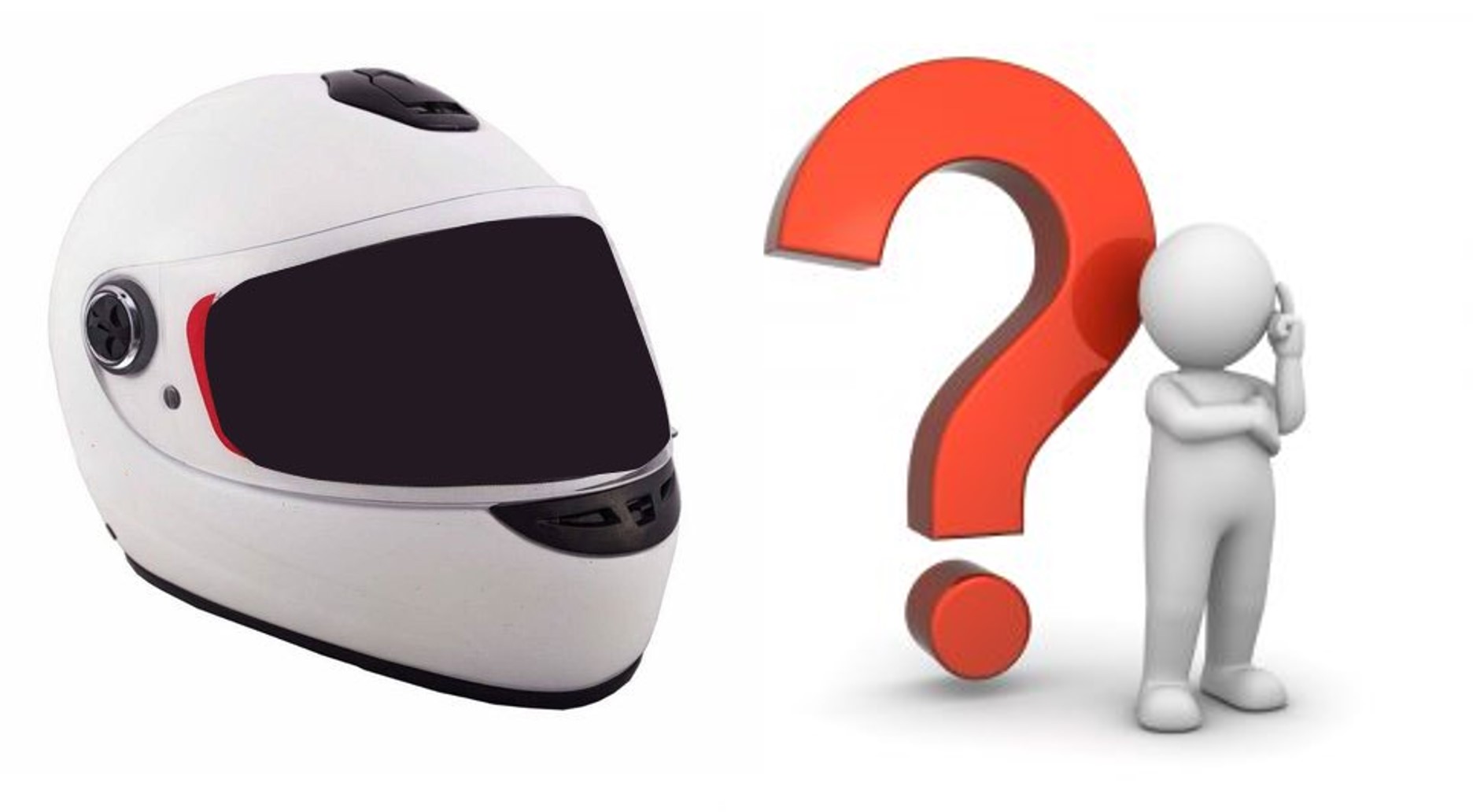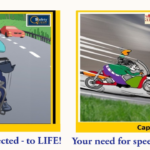
“In cricket, batsmen started using box guards from about 1878, but the helmets came on the scene only in 1978”, Farokh Engineer, India’s dashing wicketkeeper-batsman once joked. “It took us 100 years to realise that we need to protect the upper storey!”
Many people object to the use of helmets citing different reasons: they are cumbersome to carry, they strain the neck, they mess up the hair. They also feel that for short distances or intra-city commute, the helmet is not required. They do not want the law to force them to wear a helmet, it can be a choice.
Data published by the Transport Research Wing of the Government of India [1] shows that a whopping 37% of the fatalities on our roads – and we lose over 400 a day – were 2-wheeler riders, of which almost 30% were not using helmets.
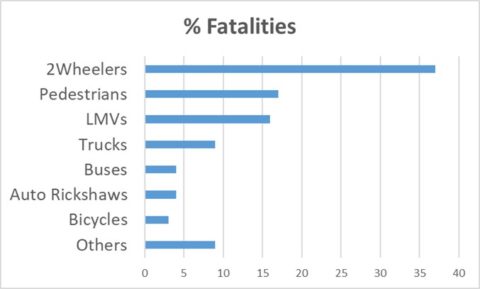
2-wheeler riders (drivers and pillion) are the most vulnerable because there is no protection around the motorcycle, and since it does not have the stability of a 4-wheeler, it can be thrown off-balance.
So let us take the help of some physics and some anatomy to understand what happens in a crash and how the helmet makes a difference.
Whether one is driving, or in a crash, the law of physics will apply [2][3][4]. Following Newton’s first law of motion, when the motorcycle’s motion is halted, the rider will continue to travel forward (after being thrown off) at the same speed until stopped by another object or the road. A head-on collision or a T-collision can lead to more severe injuries at high speed. But even at low speed, there is a risk of injury.

This is because of the vertical movement as the rider falls to the ground, and may hit the head on the side, the forehead, the back, the chin. This vertical movement is the same whether the whether the crash occurs at 20 kmph or at 60 kmph. And so, the vertical component of the velocity will be roughly the same at the time of impact. The potential energy from the seated position is now converted to kinetic energy. An average adult head weighs about 5 kg. Considering a height of 4.5 to 5.5 feet above the ground, the energy will be about 66 – 80 J, and the head will hit the ground at 19-21 kmph! Studies have shown that the human skull can crack if the impact energy is 14 – 65 J depending on the point of impact [5].
When the rider hits the ground, there is a sudden deceleration. The change in velocity is instantaneous: from 20 kmph down to 0 in a fraction of a millisecond. All the kinetic energy due to the motion is now dissipated instantly, resulting in injuries to the rider.
What does the helmet do?
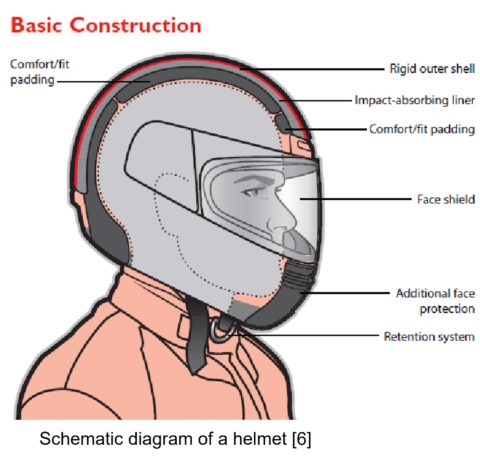
The helmet shell prevents any pointed objects penetrating. It also protects the rider from the lacerations due to friction as the horizontal movement comes to a halt.
Part of the crash energy is dissipated by the outer shell. This breaks the bonds in the material, and the shell is broken or deformed. The shell also spreads the impact over a broader area. All of which helps protect the head from damage.
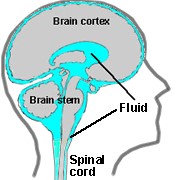 There is more. Our brain sits inside our skull, suspended in the cerebro-spinal fluid, encapsulated by a thin layer of duramater [7]. In a crash, the outer shell comes to a halt the moment it hits the ground. But the head continues to travel and will hit the helmet inside. The brain is violently shifted inside and will hit the inner wall of the skull. This can lead to concussion. The angle of impact will determine whether the brain moves to-and-fro or also goes through some twisting, stretching movements. This can lead to damage to the brain cells, affecting cognition, memory, concentration.
There is more. Our brain sits inside our skull, suspended in the cerebro-spinal fluid, encapsulated by a thin layer of duramater [7]. In a crash, the outer shell comes to a halt the moment it hits the ground. But the head continues to travel and will hit the helmet inside. The brain is violently shifted inside and will hit the inner wall of the skull. This can lead to concussion. The angle of impact will determine whether the brain moves to-and-fro or also goes through some twisting, stretching movements. This can lead to damage to the brain cells, affecting cognition, memory, concentration.
This is where the layer of foam – the impact-absorbing liner – comes into play.
The laws of Physics [2][3][4] tell us that the force acting on the skull / brain will be related to the change in the velocity, and the time over which this change occurs.
F = m (Δv) /Δt
We cannot control the mass. The change in velocity is also roughly fixed: 20 kmph, instantaneously. Therefore, to reduce the force, we must slow down the process to extend the time over which the head meets the helmet. The layer of foam has a “give” and since it gets compressed, it increases the time over about 6 to 10 msec. These pictures from lab tests [8] will give you an idea of the way foam slows down the change of velocity, and thus reduces the force of the impact.
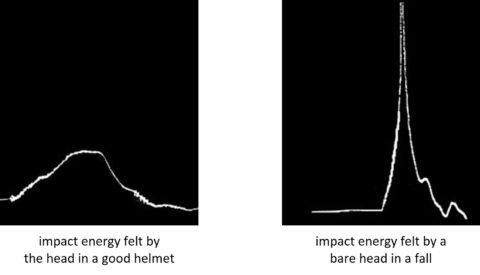
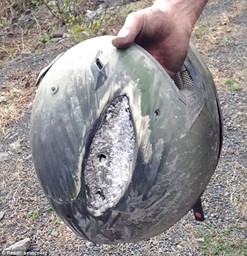
The foam used in the liner can absorb a lot of energy. In the process, the foam itself gets crushed, and stays that way. If it were to rebound, the head would be tossed once again!
As you can see in the picture, the helmet itself takes a solid beating while it protects the head. Hence, we discard helmets that have been in a crash.
There is constant endeavour to improve helmets and rider safety using newer materials that are tougher but lighter, adding layers to the liner, arranging the internal structure to distribute the impact over an even greater area. And while improving safety, there is a simultaneous attempt to make it more comfortable with the padding and the ventilation.
There is a saying in Hindi : “sir salaamat toh pagadi pachaas!” which means that if the head is in good health, one can play many different roles with ease – in the family, in the professional circles, in the community.

So, strap on your helmet snugly whether you are riding in the driver’s seat or pillion. But may it never come into play! Ride Safely!
PS : Young students who are interested, can do an egg drop experiment to understand the effect of foam; and a melon drop test to understand the overall effect of the helmet. Ask your teachers!
References
- https://morth.nic.in/sites/default/files/RA_Uploading.pdf
- https://www.physicsclassroom.com/class/momentum/Lesson-1/Real-World-Applications
- https://helmetgeeks.com/helmet-and-motion-physics-an-introduction-to-the-science-of-how-motorcycle-helmets-protect-your-head
- https://www.sportbikes.net/threads/physics-of-helmets.371666/
- Biomechanics of skull fracture https://pubmed.ncbi.nlm.nih.gov/8683617/
- https://www.researchgate.net/figure/Schematic-diagrams-showing-the-various-components-in-a-a-typical-motorcycle-helmet-41_fig9_267370663
- https://www.daviddarling.info/encyclopedia/C/cerebrospinal_fluid.html
- https://helmets.org/general.htm

